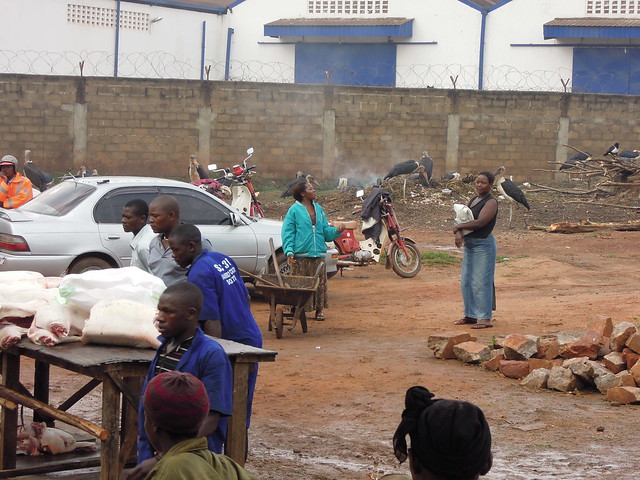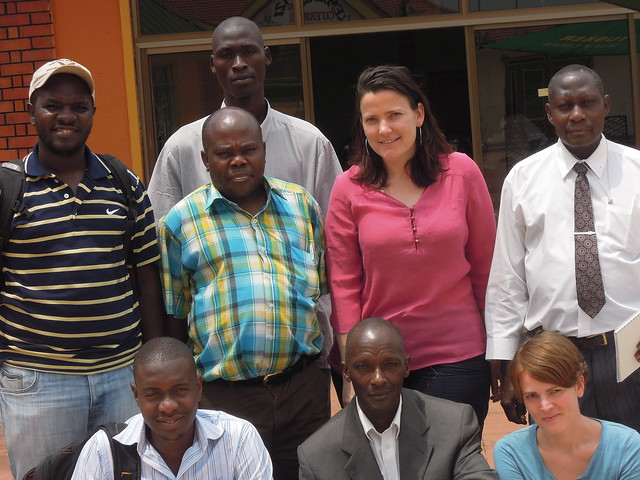
From (bio)mass to (bio)gas – or: how to efficiently utilize urban slaughter waste
The problem of slaughter waste management and its relevance to public health in Uganda has not yet been described in the literature. Zoonotic pathogens on contaminated carcasses such as E. coli, Salmonella and Cryptosporidium can be directly transmitted to meat handlers and consumers; but they can also have an indirect impact. Diseases can also be spread and transmitted to humans if 1) slaughter by-products are eaten by pest animals such as marabou storks (Svanström et al., 2014) or rodents, 2) if liquid is disposed into streams that feed into other water bodies used for drinking water (Odong et al., 2013) and irrigation, or 3) if manure is contaminated and used as fertilizers on crops (Cole DC et al., 2008). Furthermore, poor disposal practices can contribute to the intermixing of bacteria facilitating the emergence of resistances to antibiotics, a problem also emerging in Uganda (Kalule et al., 2012) and at the slaughter house subject to this pilot study (Tinega et al, forthcoming).
As part of the value chain assessment conducted by the International Livestock Research Institute (ILRI) in Uganda from 2012-2013, a descriptive study of knowledge, attitudes and practices was done at the only urban pig abattoir in Kampala. We found that slaughter waste (pig faeces, blood), by-products (genitals) as well as human excrements are not disposed systematically: solid waste is burnt once a month, blood is disposed into a stream feeding into wetlands and Lake Victoria, there are many potential wildlife vectors (rodents, marabou storks, egrets, stray dogs) that have access to waste and fresh meat and people can buy fresh manure to use it as fertilizer for their crops. These practices contribute to environmental contamination, especially of water bodies, and pose an indirect public health risk. The heavy load of waste in the proximity of the slaughter facilities coupled with poor meat handling practices, contributes to the direct contamination of pig carcasses leaving the abattoir. The slaughter house does have a cooling room but not the necessary financial means to run it on electricity. If meat is stored overnight, it is hung in the weighing house at ambient temperatures facilitating increased bacterial growth.

Daily business at the Wambizzi premises, Kampala, Uganda. Fresh meat (foreground) sold in the proximity of waste and storks (background). (photo credit: ILRI/FUB/Kristina Roesel)
Generating biogas from organic waste could provide two important benefits addressing these challenges: it can generate clean power (methane for cooking and electricity) as well as reduce the pathogen burden at the slaughter house premises leading to less cross-contamination and rendering slaughter waste into a product safe to use as fertilizer or even animal feeds. On 24 September 2014, we launched the implementation of a biogas system to manage pig slaughter waste at an urban slaughter house in Uganda. View the presentation on slideshare.
Partners:
- Green Heat Uganda is a private Uganda-based company working in the field of renewable energies and waste management. Vianney Tumwesige (with support from Gabriel Okello) will lead the assessment of slaughter waste and energy needs at the slaughter house and construct the biogas digester.
- Wambizzi Cooperative Society Ltd is the only registered pig slaughter house in Kampala and has facilitated our research over the past 2.5 years. Simon Lubega (manager), Thomas Kasule (treasurer), Jonathan Mukoopa (staff member who will be trained on operation and maintenance of the digester to ensure sustainability) will oversee the project.
- Central Diagnostic Laboratory is based at the College of Veterinary Medicine at Makerere University. Dr Edward Wampande (manager) will oversee the biological monitoring (reduction of pathogens) of the intervention.
- ILRI in Uganda is coordinating the overall project with funds from Irish Aid through the Smallholder Pig Value Chain project (led by Emily Ouma) and funds from GIZ through the Safe Food, Fair Food project (led by Kristina Roesel).
We are expecting the first results to be out by Christmas 2014! Watch this space.

Participants at the inception workshop: Back: Jonathan Mukoopa (Wambizzi) Middle (left to right): Vianney Tumwesige (Green Heat), Edward Wampande (Makerere University), Eliza Smith (ILRI), Thomas Kasule (Wambizzi) Front (left to right): Gabriel Okello (Green Heat), Simon Lubega (Wambizzi), Kristina Roesel (ILRI/Freie Universität Berlin). (photo credit: ILRI/FUB/Kristina Roesel)




















